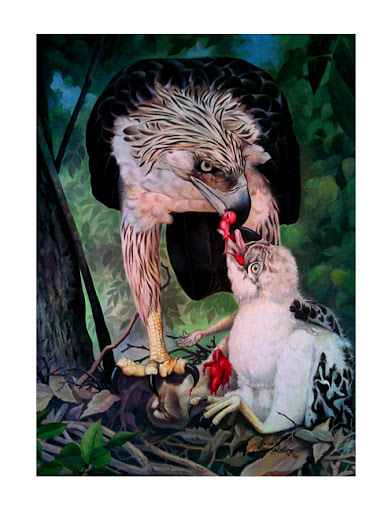
BY MADS BAJARIAS | There is something in Rene Cuvos's "Konserbatibong Maligalig" at blanc artspace in Makati City, which reminds me of the Sarah Palin phenomenon ("Coldest State, Hottest Governor") currently shaking up the US presidential race. The artist's media release helpfully points out that this painting has to do with hypocrisy in sexual matters, thus the pop culture references (which, to be honest, smack of cliches): the Playboy bunny ears, the Maria Clara dress and the sexually suggestive lolly. But really, this painting could also be how women who dare to be different confuse some men. I think women know who they are and what they want; it's men who get perplexed about how to react to women who act different, are different.
Take Sarah Palin, aspirant to the office of the US vice-presidency (or as the media like to phrase it: "a heartbeat away from the presidency"). Her inclusion in the Republican ticket turned what many observers initially thought to be an Obama-Biden coronation into a real fight for the White House. McCain's choice of little-known Palin was so outrageous it stunned even some Republicans. But what a choice! The media is agog over this ex-beauty queen, moose-hunting, salmon-fishing, devout Christian soccer mom with the sexy-stern librarian upsweep hairdo and glasses. The woman is compelling in a "sexier older sister of Tina Fey" kind of way, as one blogger put it. Outdoorsy, tough, smart, attractive, down-to-earth and (based on the Saturday Night Live skit) one of the reason for the mainstreaming of seedy terminology like MILF and FLIRJ (oh, don't make me spell these out!). One of her kids is serving in Iraq and the youngest has Down's syndrome. A daughter is pregnant out of wedlock whose boyfriend is a high school dropout. Married to a fisherman who is also a champion snow mobiler (you can't make this stuff up even if you tried). She trained to be a sportscaster but didn't want to leave Alaska and whose entry to politics began when she met her town's former mayor in a step-aerobics class. She has admitted to smoking marijuana (when it was still legal to do so in Alaska) and as current Republican governor tangles with the Big Boys of Big Oil as she presides over what may be the most socialist of US states (all long-time Alaskans get monthly checks from the oil companies operating in their area). The woman is just gangbusters.
The choice of unorthodox Palin in the Republican ticket grabbed some of Obama's "Change" message. Who's a maverick now? Palin in the limelight also exposed a strange thing in the Obama campaign: Obama isn't a good defensive candidate. He is at his best when he takes the offensive but has a hard time when his opponents counter punch, as Palin did when she belittled Obama's community organizing work in her acceptance speech. When Palin grabbed the media attention, was it any surprise when polls started registering an uptick in Republican support?
Not everyone likes her, naturally. Paparazzo-punching Lindsay Lohan ranted in her blog that Palin is "a narrow-minded media-obsessed homophobe." How Lohan knew this is a mystery. Lots of Hollywood types are coming out with anti-Palin statements, likening her conservative views to that of George W. Bush's.
Regardless of politics, Palin is just one more woman who lives her life in her own terms. Take it or leave it. It's the 21st century. Time to rid ourselves of the Madonna-whore complex. People are just complex, period. Cuvos' show "Estranghero" is ongoing until October 1 at blanc artspace in Makati City.


























